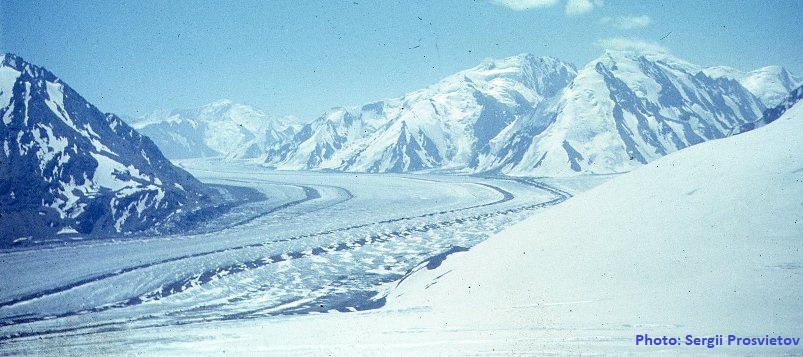
Glaciers who forgot to count
Sea level can significantly exceed scientists' forecasts
2019-09-10 13:36
One of the worst consequences of global warming is considered to be the rise in sea level due to melting ice.
When calculating the predicted level of water rise in the oceans when all the glaciers melt on the planet, the scientific world does not take into account at least two more giant glaciers, the area of which is several times greater than the Greenland ice sheet. The area of these glaciers is commensurate with the area of ice cover of Antarctica.
In addition, the glaciers that have fallen from the calculations of science lie in the latitudes of a quite temperate climate and at very low altitudes, and in some cases even below sea level. Due to this, they melt incommensurably more active than polar or mountain glaciers.
These lost glaciers do not fall into the ocean with impressive icebergs, they do not generate new gigantic streams of water and, in general, attract little attention to themselves. Their activities are secretive, although they obey all the laws of ordinary glaciers.
Unaccounted ice
The astute reader has already guessed what I call "lost glaciers." Yes Yes! This is a gigantic structure covering 60% of the area of modern Russia, as well as a significant part of Canada and Alaska. Its name is “permafrost”.
Back in 1874, with the light hand of the geographer, ideologist of anarchism, Prince Kropotkin, the concept of "permafrost" was introduced into scientific circulation. However, this apt definition of a talented person well reflected only the external manifestation of the permafrost phenomenon, but never received the exact definition of permafrost.
Apparently, this is why so many people think that permafrost is basically frozen soil, which contains some natural amount of water that has turned into ice.
How permafrost is constructed
In order to understand what constitutes permafrost, let's look at it in the incision.
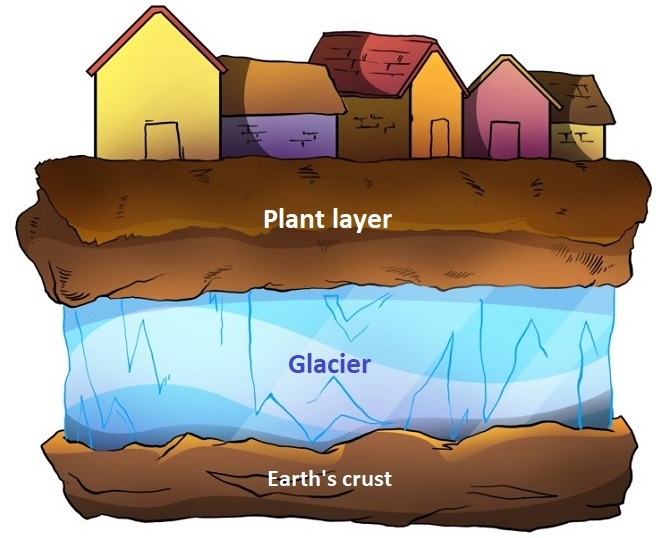
As you can see, the obligatory element of permafrost is an ice layer lying on the surface of the earth, and on top of this ice is covered with a thin (50-100 centimeters) layer of the remains of vegetation, sand and stones - on which, as on a substrate for hydroponics, modern flora grows and everything that is built by man is worth it.
In the mountains, a similar structure is called a “closed glacier”. Only a closed mountain glacier is covered not with a layer of vegetation, but with a layer of snow that hides the glacier itself and cracks in the ice.
The source of the cold, which froze the surface of the earth hundreds of meters in depth, is ice. It is this ice that covers the planet’s surface in the permafrost zone that should be considered a key element in the structure of permafrost.
How permafrost lives
In order to maintain the soil in a frozen state, the source of cold must act continuously for many thousands of years. Otherwise, permafrost will quickly melt under the influence of the energy of the sun and natural earthly heat coming from the red-hot depths of our planet. After all, as you know, in places where there is no permafrost, the temperature of the earth's crust rises by about 3 degrees for every 100 meters inland.
Thus, the ice layer is not only the main structural element of permafrost, but also the main factor that created permafrost and frozen soils for tens of thousands of years - judging by the age of the preserved remains of mammoths and other representatives of the ancient fauna and flora.
It is very important to understand that permafrost was not formed under the influence of atmospheric cold, since in Siberia and Alaska permafrost extends far to the south and reaches those geographical latitudes where there is no permafrost in other places of land (for example, in Europe).
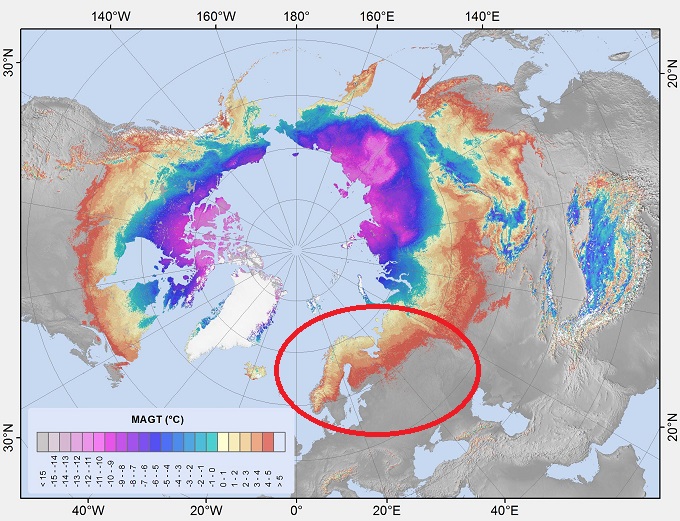
Permafrost was formed under the influence of ice that covered the earth tens of thousands of years ago. What we call permafrost is actually a glacier, which is covered on top with a plant layer. Permafrost is the remnants of that ice that was thrown onto land several tens of thousands of years ago.
How does the fertile layer on permafrost arise
To complete the picture, let's see how a fertile layer was formed on the surface of perennial ice.
When the ice surface melts under the influence of solar heat, all impurities - sand, pebbles, ash particles of distant volcanoes that fell into the ice during its formation, remain on the ice surface and gradually accumulate. Foreign particles seem to “float” out of the ice in the process of melting the glacier. These particles form the basis of the fertile layer. Then new dust brought by the winds lays on this layer, and with it the seeds of plants.
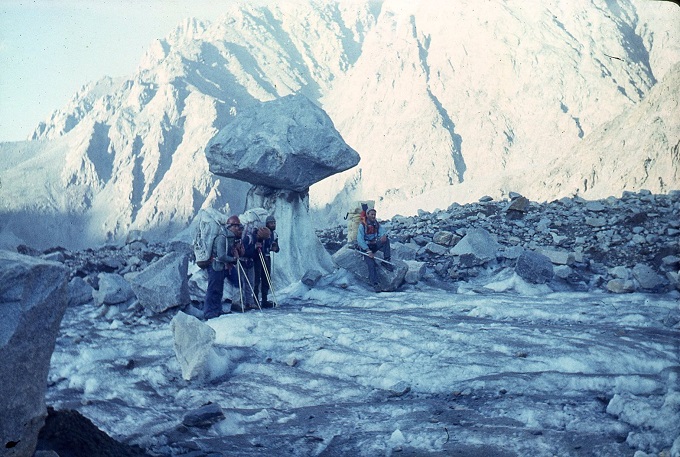
The ice under the stones melts more slowly than the steel surface of the glacier and thus all the stones, sand and other solid particles accumulate on the surface of the glacier.
From the seeds brought by the wind and birds, the first vegetation appears. But at the end of the life cycle, the flora, settled on ice, does not decay, but remains on the surface of the ice. It does not form soil, since vegetation does not decompose on the cold surface of ice, but it creates a certain hygroscopic layer in which new dust and the remains of obsolete vegetation accumulate.
Thus, the fertile layer grows and turns into what we see today: a conglomerate of sand and plant debris on which, like when growing vegetation by the hydroponic method, trees, shrubs, grasses and mosses grow.
This fertile layer provides additional thermal insulation of the glacier and thus slows down its melting.
Let's call a glacier as glacier
Now that we know how permafrost works, let's compare it with an ordinary mountain glacier.
In the mountains there is a glacier itself, there is a rock frozen over tens of meters deep and there is even a kind of fertile substrate for the growth of flora.
The right question arises: why do we call the same phenomenon in one case a glacier, and in another case we call permafrost? And while you are thinking about the answer, I myself will answer this question: Pyotr Alekseevich Kropotkin, under the meter of the fertile layer, did not make out a giant glacier. There are no other explanations.
There is no such independent natural phenomenon of “permafrost”. There is ice and everything that is generated by ice. Be it in the open spaces of Siberia, high in the mountains or at the poles of the planet. And permafrost is a necessary and indispensable addition to any glacier, no matter how this glacier appears and wherever this glacier is.
It is glaciers that cause freezing of the soil beneath them, and not vice versa, since the cold spreads from top to bottom, and not vice versa. A glacier lying on the surface of the earth freezes the soil beneath it, and not vice versa.
Thus, what is commonly called permafrost in Siberia, Canada and Alaska is actually the so-called closed glacier. Only in contrast to mountain glaciers, covered from the eyes with a layer of snow, is this glacier hidden from us by a fertile layer and vegetation. And the water reserves stored in the strata of these glaciers should be taken into account when calculating sea level rise and other possible consequences of global warming.
According to the law of glaciers
Another feature of permafrost, the most important feature that few understand, is that permafrost does not live according to the laws of the earth’s firmament. Permafrost lives according to the laws of glaciers, much like the mountain glaciers and glaciers of Greenland and Antarctica live
The peculiarity of the life of glaciers is that ice has some fluidity (plasticity) and is in constant motion. Like water, ice constantly flows from top to bottom. And since the plasticity of ice is not unlimited, cracks form on the turns of its channel and on the bends of the terrain in the ice. Further, on flat areas, ice again merges into a monolithic structure.
The following picture is vivid evidence of the glacial nature of permafrost.
Light streaks of vegetation formed over cracks in the ice beneath them. Here, the glacier slides into the deepening of the lake, and at the bend of the terrain breaks into pieces - separate ice floes. At the edge of the lake, where the zone of cracks is continuous, water flows down into the lake, and to the right and further from the lake, the cracks are not yet through, and here on the surface of the tundra meltwater puddles gather.
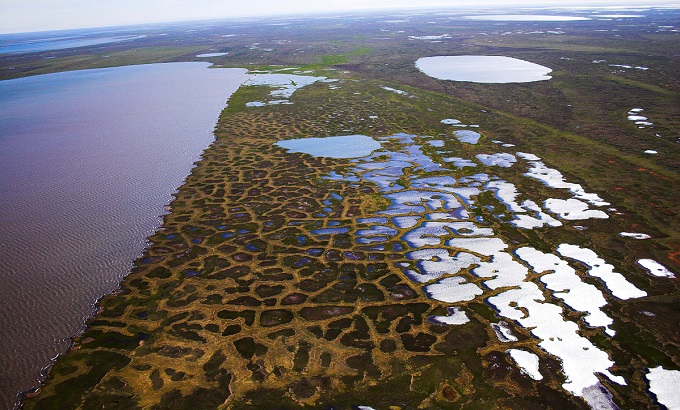
And here is another eloquent picture showing the glacial nature of permafrost. Everyone who is familiar with the life of mountain glaciers can read this letter without difficulty.
Here the glacier overcomes a rock sticking out on its way. Ice moves from the lower left corner of the image towards the upper right corner. At the top of the cliff in the ice several wide cracks form, which are compressed on the descent from the cliff. The zone of cracks "lives" for some time after the obstacle, then on a flat place the ice again merges into a monolithic stream.
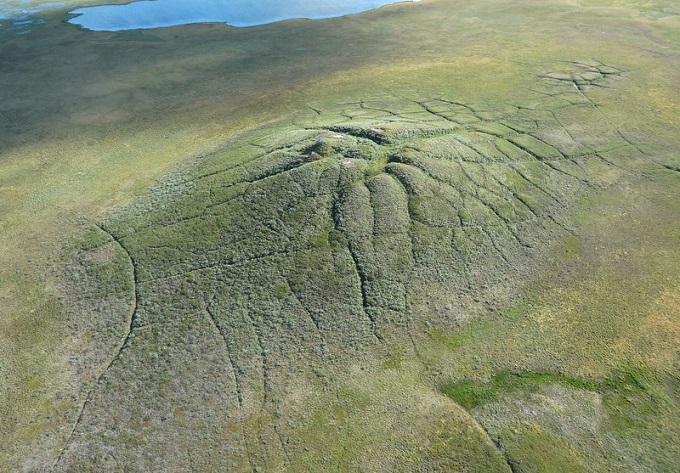
Similarly, ice looks where the forest grows above it, but behind the forest it is more difficult to see cracks in the glacier.
Thanks to the giant glacier underlying them, such large-scale forests were formed in Siberia. In the warm season, the upper layer of ice thaws and nourishes moisture with trees, shrubs and other vegetation. But once cracks form in the ice, meltwater goes into the ice channels and wild forest vegetation dies, forming dead woods and debris of the dry land. In such places large-scale forest fires easily arise.
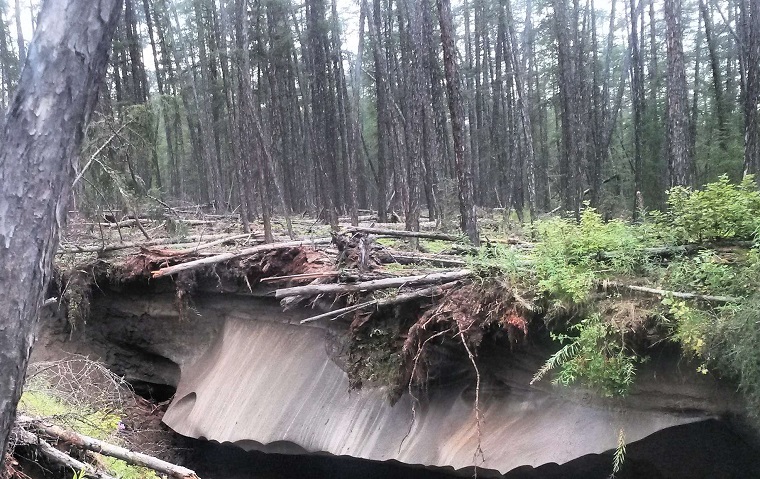
The vegetation growing on the surface of the glaciers has no other sources of water than melted ice and precipitation. Aquifers located in the ground will remain frozen for many years.
Ice and water
In the process of ice melting, water in a liquid state actively interacts with ice - frozen water. It is interesting that meltwater does not freeze either on the surface of the glacier or in its ice depths, causing a phenomenon called thermokarst.
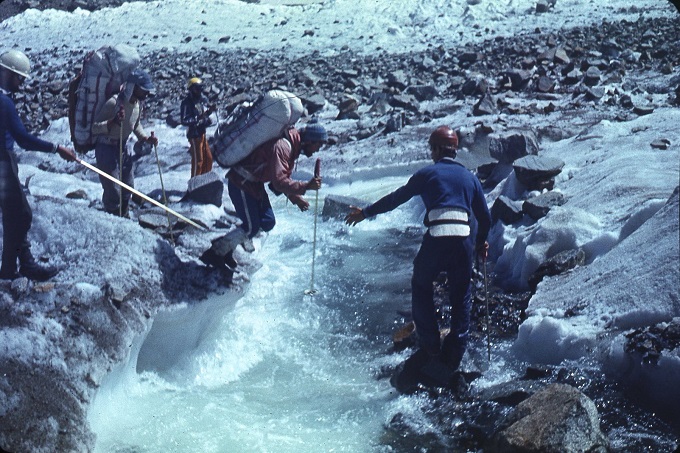
Thermokarst is channels and cavities in the body of a glacier that wash melt water, just as water leaches karst caves in the strata of karst rocks. And the meltwater that has collected in the lakes on the surface of the glacier gradually melts into the depths of the glacier, forming mysterious dips-wells. Such ice funnels are formed in those places where there is already an aquifer under them in the ice mass. Then the ice is heated not only by the lake on its surface, but also by the water flowing in the thickness of the ice.
The following picture was taken from the bottom of one of the ice craters in Yakutia during the polar night when the water freezes, but here you can clearly see the cave flowing out of the ice funnel.
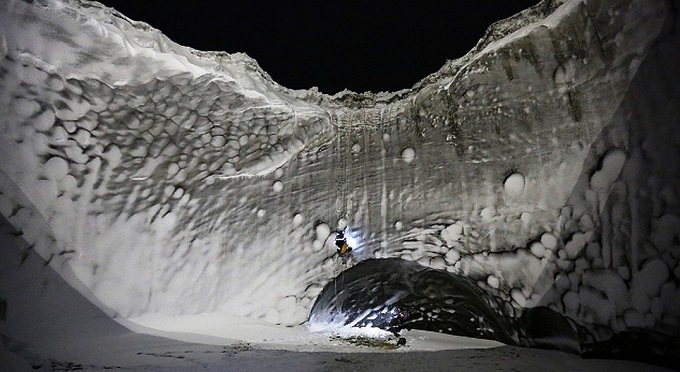
Thermokarst formations in glaciers are dangerous in that they develop hidden from our eyes, but sometimes have cyclopean scales. Entire rivers of water can flow in the thickness of the ice, large subglacial lakes can form, which cause rapid melting of the surrounding ice, which in turn leads to the breakthrough of large masses of water to freedom. This is how unpredictable major floods occur in Siberia.
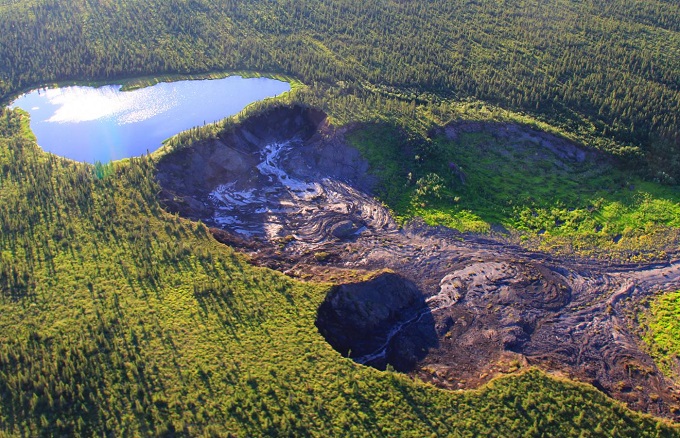
The greatest danger of thermoskar formations is that their orography is not known and difficult to study, and the consequences of breaking ice dams can have disastrous consequences. In the mountains, such phenomena are not uncommon when meltwater breaks through glacial dams and rushes down the riverbed.
It is difficult to estimate how much the ice masses, which are erroneously called permafrost, are penetrated by thermokarst rivers and lakes, and after all the liquid water inside the glacier is not only a powerful accelerator of melting ice, it gets into the ocean very quickly along riverbeds, causing its level to rise.
Scale of unaccounted ice
Since what is actually ice, our science still calls it “permafrost,” giant glaciers lying under a thin layer of vegetation are not included in the calculations of the consequences of melting ice. That is the reality.
But what is the extent of this unaccounted for?
|
Permafrost Territory |
Permafrost area in square kilometers |
|
Russia |
11 000 000 |
|
North America |
7 200 000 |
|
Total |
18 200 000 |
And here are the areas of the largest glaciers:
|
Territory |
The area of ice in square kilometers |
|
Antarctica |
14 000 000 |
|
Greenland |
1 830 000 |
|
Arctic Ocean |
4 330 000 |
|
Total |
20 160 000 |
As you can see, the total area of the largest ice storage in the world is commensurate with the area covered by hidden glaciers only in the northern hemisphere of our planet, glaciers, which so far science calls "permafrost".
Of course, I understand that you need to measure not the area of glaciers, but their volume. But who measured the volume of ice hidden by the vegetation, if they are still not considered glaciers?
But it is the closed glaciers of Siberia and North America that melt most intensively today. It is they who not only actively replenish the level of the world's oceans, but also replenish the planet’s atmosphere with new flows of greenhouse gases, which accelerate the further melting of all the ice on the planet.
Ark for planet Earth
It’s time to understand that the whole energy power of mankind is absolutely nothing in comparison with the energy of the Sun, continuously supplied to the Earth. Reducing emissions of industrial greenhouse gases, of course, is necessary. But it should also be understood that this is not a solution to the problem, but rather a large commercial project.
For humanity, it is time to reap the benefits of ancient natural disasters. To solve these problems, people must find other forms of unification where there are no rich and poor, where there is no G7, G20 - and "everyone else".
The permafrost zone in Siberia is a giant glacier - about the same as the glaciers of Antarctica or Greenland. This glacier lies on the surface of the mainland, and on top is covered with a thin (about half a meter) layer of soil (we will call it conditionally). This layer of soil and vegetation on it is the only thing that distinguishes permafrost from open glaciers lying in the mountains, in Greenland or in Antarctica.
The permafrost of Siberia, Alaska and Canada is not just deep frozen soil. Permafrost is not yet the melted remains of an ancient glacier that covered these territories tens of thousands of years ago. This ice was preserved due to the fact that over the millennia of its existence, its surface was covered with a layer of thermal insulation, which we now call soil. Later, forests and other vegetation grew on this soil.
It is ice that is the basis on which tundra vegetation and taiga forests grow. It is ice that is the foundation on which people built their roads, cities and villages. All this will be destroyed.
We will all be saved on one ark and it is time to start building this ark.
Author: Sergii Prosvietov.
Каждый ваш вклад имеет большое значение. Поддержите независимые научные исследования автора и помогите более глубоко изучать важные темы сегодняшнего дня
Пополнить банку на независимые научные исследования
Author: Sergii Prosvietov
Просмотров всего: 2409 Просмотров сегодня: 198
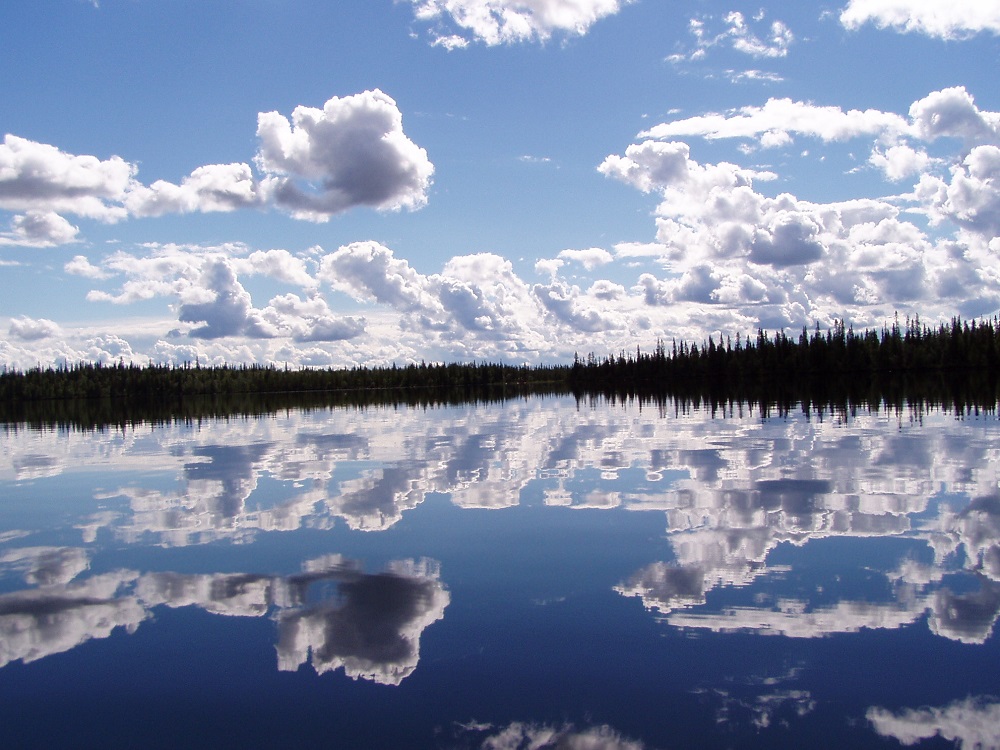
Climate Memory
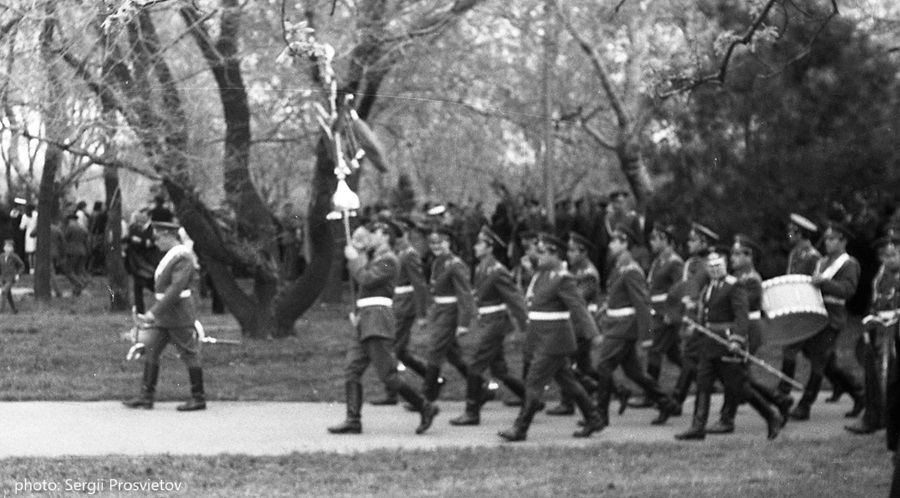
The collapse of the Union